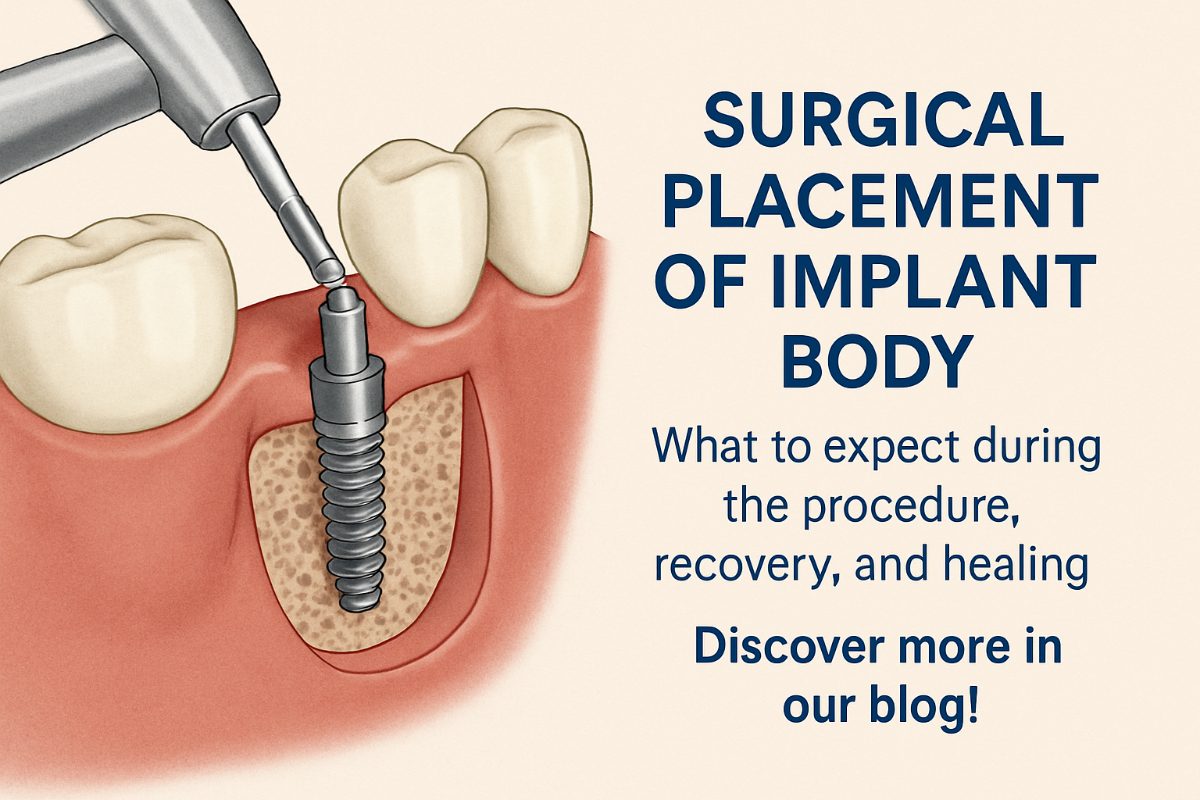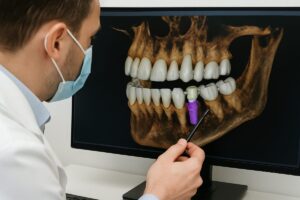The surgical placement of implant body is the step where your dentist or specialist places the metal fixture into your jawbone that will hold a replacement tooth. This visit focuses on safety, comfort, and accuracy — your dentist will review your plan, go over anesthesia options, place the implant using guided imaging, and explain aftercare so you know what to expect during healing.
What Is the Surgical Placement of Implant Body?
The implant body (sometimes called the fixture) is a titanium screw placed into the jawbone. Over weeks to months the bone fuses to the implant in a process called osseointegration. Once stable, the implant supports a crown, bridge, or denture and acts like a natural tooth root.
How Dentists Plan for Implant Surgery
Initial exam and medical history
Your dentist will check your mouth, gums, and overall health. They’ll ask about medications, bleeding disorders, heart conditions, or diabetes. This helps reduce risks and ensures any needed precautions or antibiotic plans are in place.
Imaging and 3D planning
CBCT scans and digital models map bone, nerves, and sinus locations. This 3D planning shows the best implant position and angle. Many practices use surgical guides or robotic assistance to place implants more precisely.
What Happens During the Surgery
You’ll get local anesthesia, and usually sedation if needed. The dentist makes a small incision, drills pilot holes at planned depths, and places the implant body into the bone. The area is sutured closed. Most single-implant procedures take about 30–90 minutes, depending on complexity.
What to Expect Right After Surgery
Expect mild bleeding, swelling, and soreness the first 48–72 hours. Use ice, take prescribed or over-the-counter pain relief, and stick to soft foods. Avoid heavy lifting and smoking. Follow post-op instructions for cleaning and medications to lower infection risk.
Risks, Complications, and How They’re Managed
Common risks include infection, swelling, temporary nerve irritation, or failure to integrate. Dentists reduce these risks with careful planning, sterile technique, and follow-up care. If problems occur, treatments range from antibiotics and mouth rinses to revision surgery in rare cases.
Healing Timeline and When Restorations Happen
Osseointegration typically takes 3–6 months. You’ll return for follow-up checks and imaging. Once the implant is stable, the dentist will attach an abutment and then the final crown, bridge, or denture. Some cases allow immediate temporary teeth; your provider will confirm what’s safe for you.
Frequently Asked Questions Patients Ask About Implant Surgery
Q: Is it painful? A: Most patients report manageable discomfort controlled with medication and home care. Numbness during the procedure prevents pain. Q: How long does recovery take? A: Initial healing is 48–72 hours for pain/swelling; full bone healing is months. Q: Will I need bone grafting? A: Sometimes. If bone is thin or missing, grafting helps create a stable base for the implant. Q: Can I drive home? A: If you had sedation, arrange a ride. For local anesthesia only, you can usually drive.
About Gwinnett Dental Implant Center
Gwinnett Dental Implant Center in Lilburn, GA offers combined periodontal and surgical care with a patient-first approach. The team focuses on safety, clear communication, and individualized plans. They offer flexible financing and bilingual staff to make treatment more accessible.
Meet the Doctors
Dr. Melody Schiffer and Dr. Nisha Kancherla are board-certified periodontists with advanced training in implants and periodontal care. They handle complex cases and prioritize predictable outcomes.
Advanced Technology That Improves Outcomes
The practice uses CBCT imaging, All‑On‑X options, and an on-site master lab for faster, precise restorations.
How to Schedule a Consultation
Bring a list of medications, medical history, and any prior dental imaging to your first visit. Call the office or use the online form to book an implant evaluation and get a clear, personalized treatment plan.








